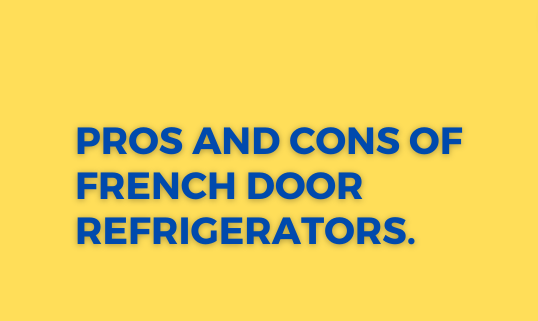French door refrigerators are a popular choice for many households due to their elegant design and functionality. They feature two side-by-side doors for the refrigerator compartment and a bottom freezer drawer, providing easy access to fresh food while also offering ample storage space. Below are pros and cons of French door refrigerators:
Pros:
- Spacious storage: French door refrigerators offer generous storage capacity, making it easier to organize and access food items.
- Flexible shelving: Adjustable shelves allow for customizable storage configurations to accommodate larger or odd-shaped items.
- Wide refrigerator compartment: The wider refrigerator section provides ample space for everyday food items.
- Convenient layout: The double doors make it convenient to access frequently used items without fully opening the refrigerator.
- Energy-efficient design: French door refrigerators often come with energy-saving features like LED lighting and efficient cooling systems.
- Bottom freezer: The bottom freezer design makes it easier to access frozen foods without bending down.
- Separate temperature controls: Dual-zone temperature controls for the refrigerator and freezer allow for optimal storage conditions.
- Enhanced organization: Features like adjustable door bins, slide-out shelves, and specialized compartments help organize food items.
- Temperature consistency: French door refrigerators often have advanced cooling systems that maintain consistent temperatures throughout.
- Fresher food preservation: Many French door refrigerators include humidity-controlled crispers and specialized storage drawers for better food preservation.
- Water and ice dispensers: Some models come with built-in water and ice dispensers, providing convenience and saving countertop space.
- Sleek and modern design: French door refrigerators add an elegant and contemporary touch to kitchen aesthetics.
- Increased freezer capacity: The bottom freezer design typically offers more freezer space compared to traditional top-freezer models.
- Accessibility for differently abled individuals: The side-by-side door design of French door refrigerators can be more accessible for individuals with mobility challenges.
- Noise reduction: Advanced insulation and compressor technology in French door refrigerators contribute to quieter operation.
- Child lock feature: Many models include child lock options to prevent unauthorized access or tampering.
- Specialized storage compartments: Some French door refrigerators have compartments dedicated to specific items like wines, snacks, or deli meats.
- Improved visibility: Well-designed interior lighting ensures better visibility of stored items, reducing the chances of food waste.
- Increased resale value: French door refrigerators are highly sought after and can add value to a home during resale.
- Customizable paneling: Some models allow for custom paneling to match kitchen cabinetry, providing a seamless look.
Cons:
- Higher cost: French door refrigerators tend to be more expensive compared to other types of refrigerators.
- Limited space for large items: The design of French door refrigerators may limit storage space for bulky or oversized items.
- Frequent bending for freezer access: Accessing the freezer requires bending down, which can be inconvenient for some individuals.
- Reduced freezer organization: The drawer-style freezer may not offer as many organizational options as upright or side-by-side freezers.
- Bulkier door swing: The wide door swing of French door refrigerators requires more space for clearance, which can be challenging in smaller kitchens.
- Fingerprints and smudges: Stainless steel models are prone to showing fingerprints and smudges, requiring regular cleaning.
- Limited door storage: The design of French door refrigerators may limit the capacity and size of door storage bins.
- Reduced freezer visibility: With a bottom freezer, it may be more challenging to see and access items stored in the back.
- Longer defrosting time: The defrosting process for French door refrigerators may take longer due to the larger freezer size.
- Maintenance and repair costs: Repairing or replacing components in French door refrigerators can be more expensive compared to other models.
- Inefficient use of space: The wider refrigerator compartment may result in wasted space if not properly organized.
- Limited customization options: The design and layout of French door refrigerators may not suit everyone’s preferences or kitchen layout.
- Increased energy consumption: Some French door models consume more energy due to the larger size and additional features.
- Potential for air leakage: The double doors can allow more air exchange, which may affect temperature consistency.
- Restricted placement options: French door refrigerators may require specific clearance space around them for optimal performance.
- Limited availability of compact models: French door refrigerators are less common in compact or smaller size options.
- Weight of the doors: The weight of French door refrigerator doors can be heavier, requiring more effort to open and close.
- Potential for door slamming: The weight of the doors and the design may lead to accidental door slamming if not handled carefully.
- Inconvenient for tight spaces: The wide doors may be impractical in kitchens with limited space or narrow doorways.
- Reduced ice production: Some French door models have smaller ice maker capacities compared to other refrigerator types.
Pros
- Spacious storage
- Flexible shelving
- Wide refrigerator compartment
- Convenient layout
- Energy-efficient design
- Bottom freezer
- Separate temperature controls
- Enhanced organization
- Temperature consistency
- Fresher food preservation
- Water and ice dispensers
- Sleek and modern design
- Increased freezer capacity
- Accessibility for differently abled individuals
- Noise reduction
- Child lock feature
- Specialized storage compartments
- Improved visibility
- Increased resale value
- Customizable paneling
Cons
- Higher cost
- Limited space for large items
- Frequent bending for freezer access
- Reduced freezer organization
- Bulkier door swing
- Fingerprints and smudges
- Limited door storage
- Reduced freezer visibility
- Longer defrosting time
- Maintenance and repair costs
- Inefficient use of space
- Limited customization options
- Increased energy consumption
- Potential for air leakage
- Restricted placement options
- Limited availability of compact models
- Weight of the doors
- Potential for door slamming:
- Inconvenient for tight spaces
- Reduced ice production

